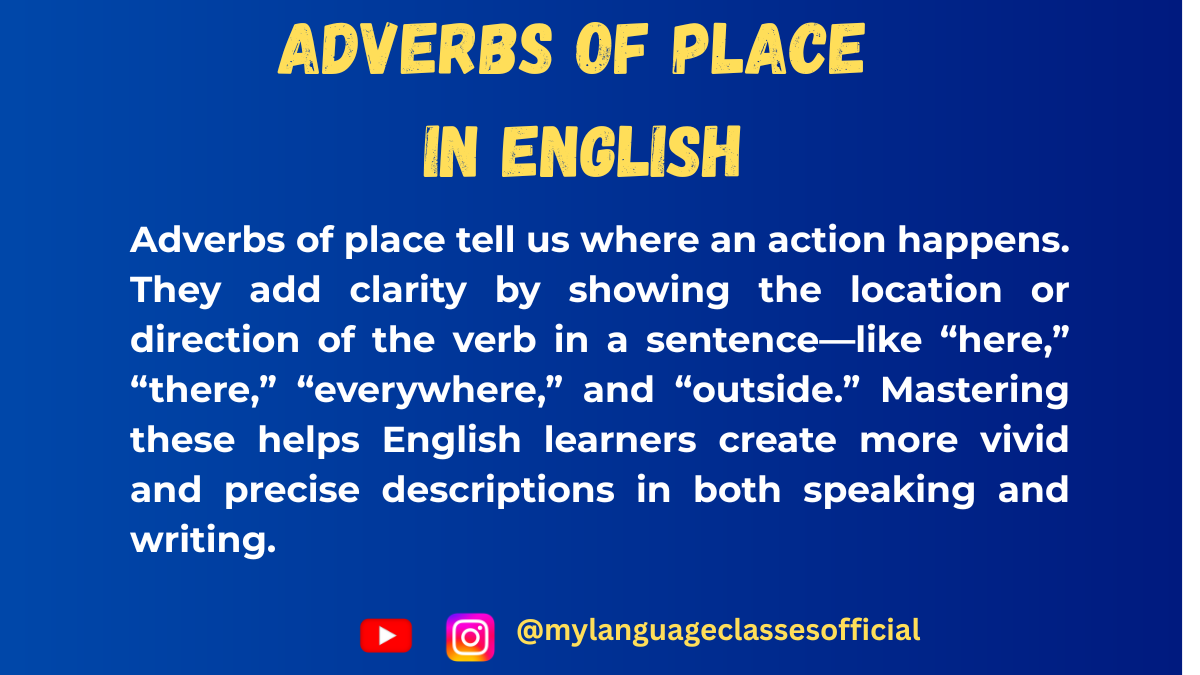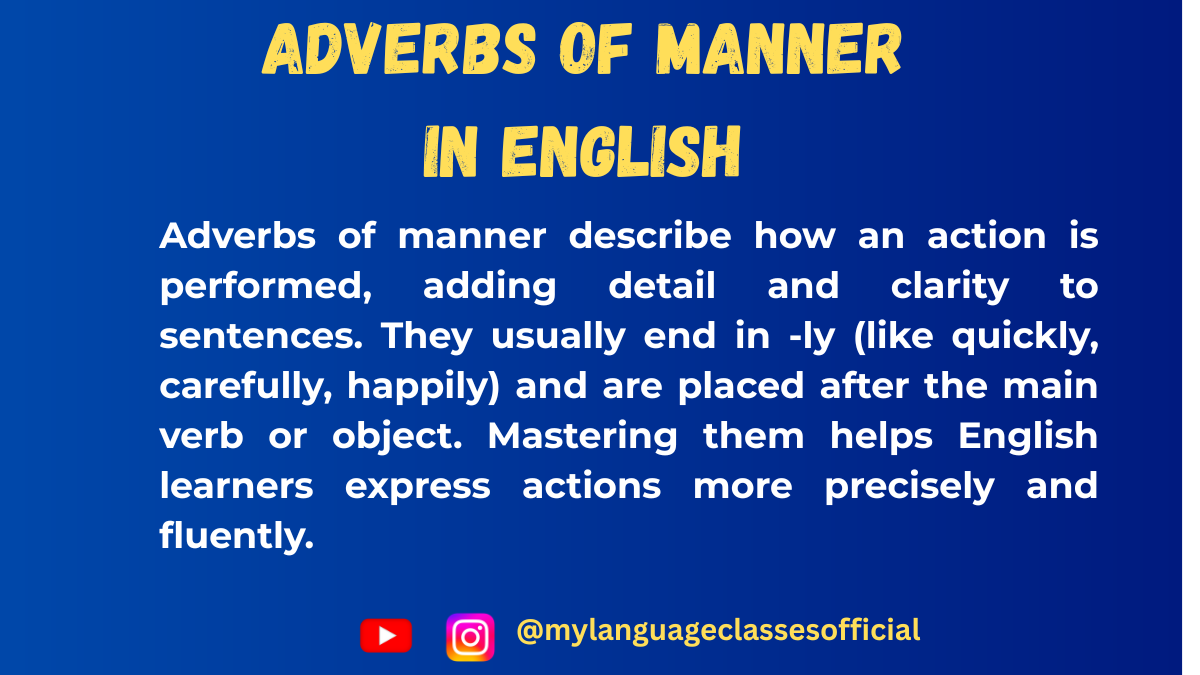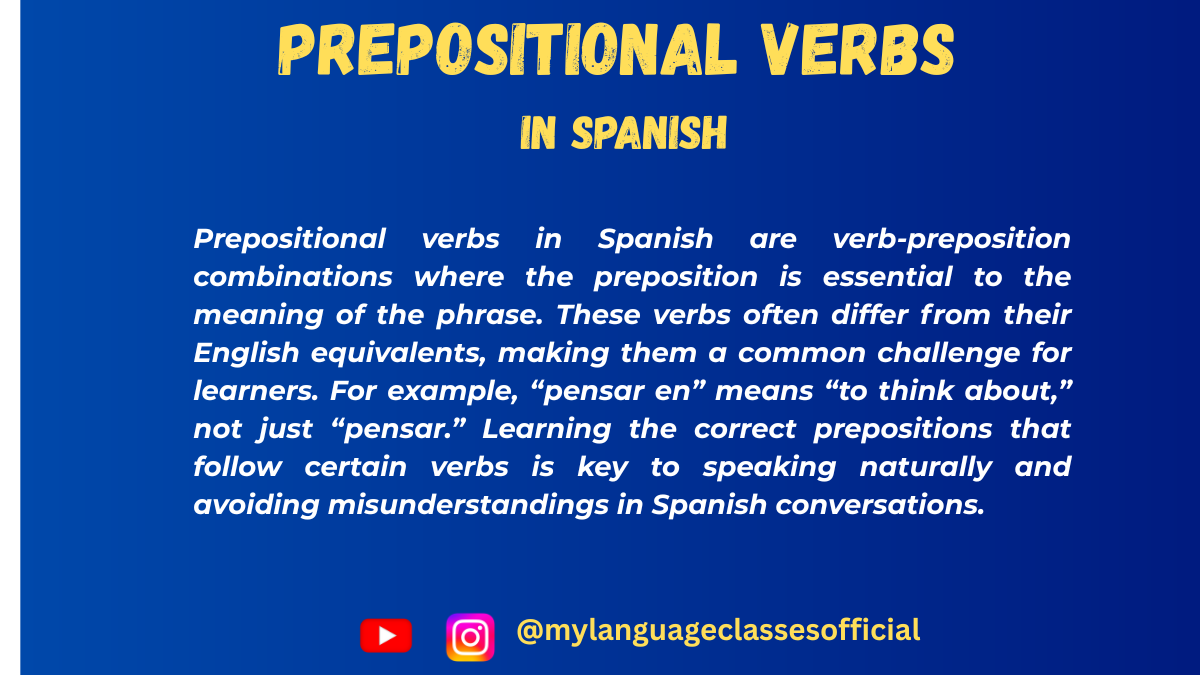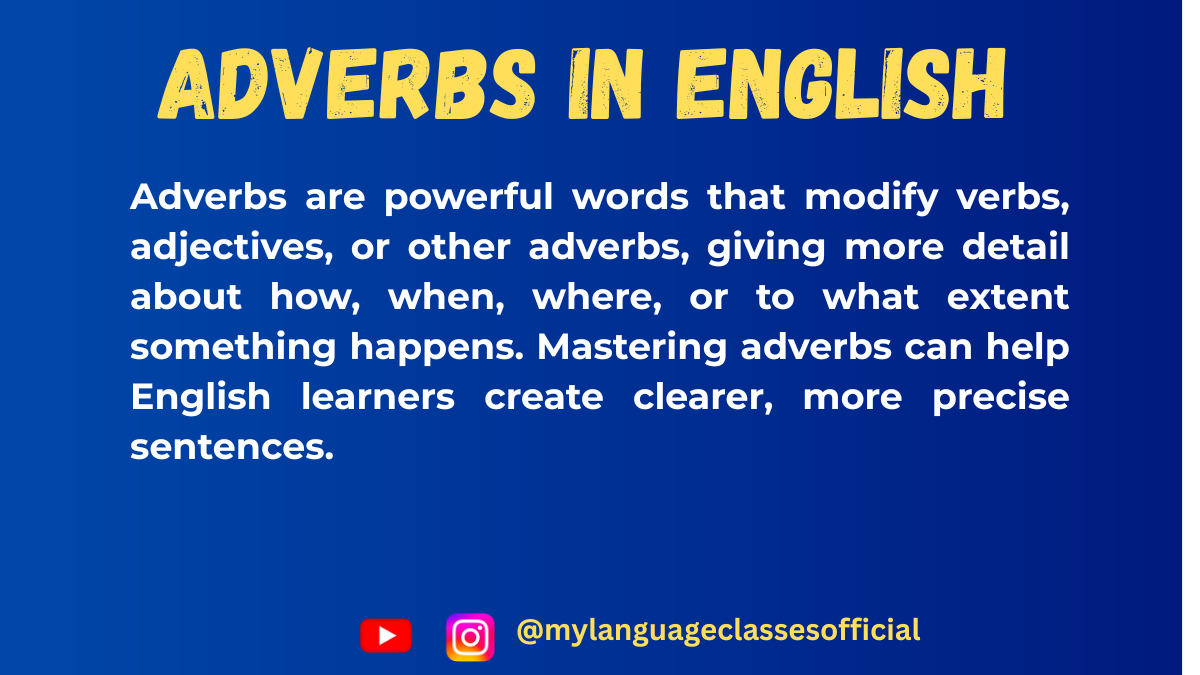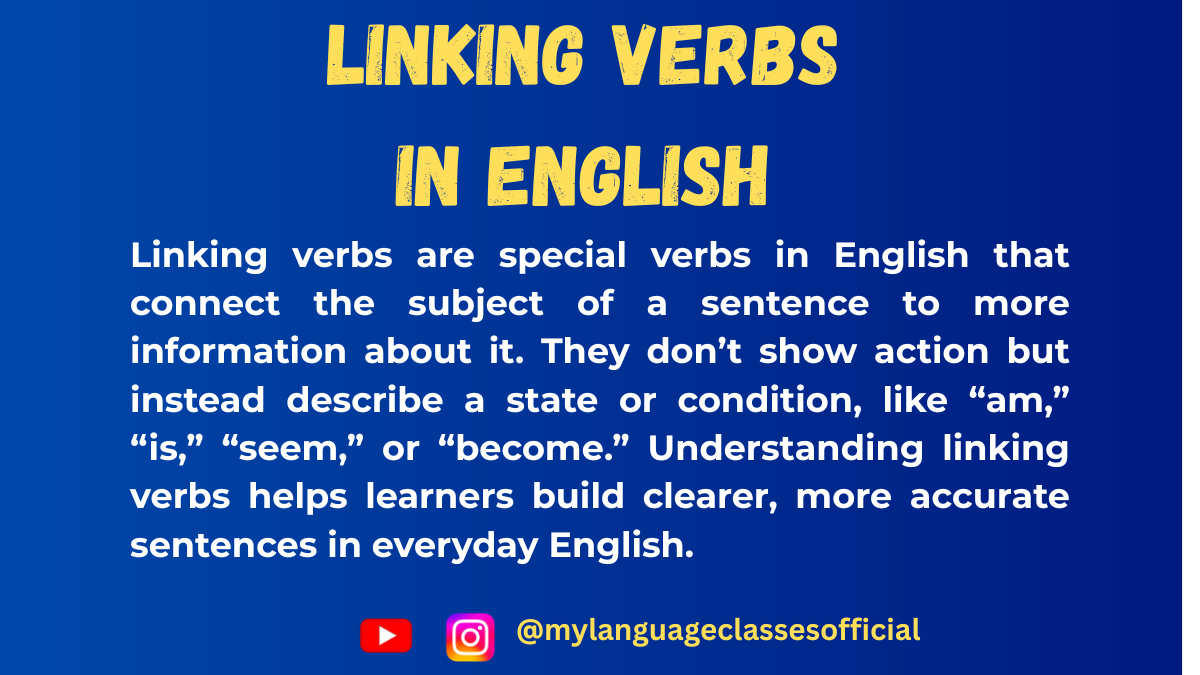Your cart is currently empty!
Tag: writing
-

Adverbs of Frequency in English: Usage, Rules, and Examples
Adverbs of frequency are an essential part of English grammar, helping us express how often an action occurs. They answer the question “How often?” and provide clarity in both spoken and written communication. Whether you’re a beginner or an advanced learner, mastering these adverbs will enhance your fluency and precision in English.
In this blog post, we will explore common adverbs of frequency, their usage, grammar rules, and key points to remember. We will also include examples, exercises, and answers to solidify your understanding.
Common Expressions
Here are some of the most commonly used adverbs of frequency, listed from most frequent to least frequent:
- Always (100%) – “She always wakes up early.”
- Usually (90%) – “He usually drinks coffee in the morning.”
- Frequently (80%) – “They frequently visit their grandparents.”
- Often (70%) – “I often go to the gym after work.”
- Sometimes (50%) – “She sometimes forgets her keys.”
- Occasionally (30%) – “He occasionally eats junk food.”
- Seldom (20%) – “They seldom watch television.”
- Rarely (10%) – “I rarely go to the beach.”
- Hardly ever (5%) – “She hardly ever drinks soda.”
- Never (0%) – “He never smokes.”
Usage of Adverbs of Frequency
Adverbs of frequency are used in various situations:
- To describe habitual actions:
- “I always brush my teeth before bed.”
- To talk about general truths:
- “The sun always rises in the east.”
- To describe routines and habits:
- “She often goes jogging in the park.”
- To express the likelihood of events:
- “He rarely forgets his homework.”
Grammar Rules for Adverbs of Frequency
To use adverbs of frequency correctly, follow these rules:
1. Placement in a Sentence
- Before the main verb:
- “She usually studies in the library.”
- After the verb ‘to be’:
- “He is always on time.”
- Before auxiliary verbs (do, have, will, etc.):
- “They have never been to Spain.”
- Between modal verbs and the main verb:
- “You should always wear a seatbelt.”
2. Negative Sentences
- Place adverbs of frequency before the main verb:
- “I never eat fast food.”
- “She rarely complains about work.”
- When using auxiliary verbs, place the adverb after the auxiliary verb:
- “I haven’t often seen him at school.”
3. Questions
- Use adverbs of frequency to ask about habits:
- “Do you usually wake up early?”
- “Does he often play soccer?”
Things to Keep in Mind
- “Never” is already negative, so do not use “not” with it.
- ❌ “I don’t never skip breakfast.”
- ✅ “I never skip breakfast.”
- “Hardly ever” is different from “never.”
- “He hardly ever watches movies.” (Means very rarely, not zero times.)
- “Sometimes” and “occasionally” can start or end a sentence.
- “Sometimes, I go for a walk in the evening.”
- “I go for a walk in the evening sometimes.”
- “Always” cannot be used in negative sentences. Instead, use “never.”
- ❌ “I don’t always eat breakfast.”
- ✅ “I never eat breakfast.”
Example Sentences
- She always arrives on time.
- I usually read a book before bed.
- They frequently visit their relatives.
- He often goes hiking on weekends.
- We sometimes eat out for dinner.
- You occasionally watch movies at night.
- They seldom argue with each other.
- She rarely drinks soda.
- I hardly ever go to the theater.
- He never skips his morning run.
- She always smiles at strangers.
- I usually listen to podcasts on my commute.
- They frequently attend concerts.
- He often helps his neighbors.
- We sometimes forget important dates.
- You occasionally try new recipes.
- They seldom visit the countryside.
- She rarely eats junk food.
- I hardly ever watch TV.
- He never lies to his friends.
Exercise: Fill in the Blanks
Fill in the blanks with the correct adverb of frequency. The word to be used is provided in parentheses.
- She ____ drinks coffee in the morning. (always)
- They ____ go on vacation in December. (usually)
- He ____ forgets his homework. (rarely)
- We ____ eat fast food. (sometimes)
- You ____ make the same mistake. (never)
- I ____ help my brother with his studies. (often)
- She ____ goes for a walk after dinner. (occasionally)
- He ____ complains about his work. (hardly ever)
- We ____ see him at family gatherings. (seldom)
- They ____ play video games. (frequently)
Answers
- She always drinks coffee in the morning.
- They usually go on vacation in December.
- He rarely forgets his homework.
- We sometimes eat fast food.
- You never make the same mistake.
- I often help my brother with his studies.
- She occasionally goes for a walk after dinner.
- He hardly ever complains about his work.
- We seldom see him at family gatherings.
- They frequently play video games.
Summary
- Adverbs of frequency describe how often something happens.
- Common examples: always, usually, frequently, often, sometimes, occasionally, seldom, rarely, hardly ever, never.
- Placement: Before the main verb, after the verb “to be,” or between auxiliary/modal verbs and the main verb.
- Negative sentences: Use “never” instead of “not always.”
- Questions: Adverbs of frequency are used to ask about habits and routines.
Conclusion
Mastering adverbs of frequency will greatly improve your English fluency and clarity. By understanding their correct placement and usage, you can confidently express how often actions occur. Keep practicing with real-life examples and exercises to solidify your understanding.
👉 Visit our blog: mylanguageclassesblog.wordpress.com
👉 Follow on Instagram for daily tips
👉 Subscribe on YouTube for fun grammar videos.Let’s grow your English fluency together—one word at a time!
-

Indirect & Direct Object Pronouns Combined in Spanish Grammar
Mastering Spanish pronouns can be challenging, especially when both indirect and direct object pronouns are used together in a sentence. In this comprehensive guide, we will explore how to combine these pronouns correctly, following grammar rules, common expressions, usage scenarios, and conjugations. By the end, you’ll be able to construct natural-sounding Spanish sentences with confidence!
Common Expressions Using Indirect & Direct Object Pronouns Combined
Here are some commonly used expressions in Spanish where both pronouns appear together:
Spanish Expression English Meaning Te lo dije. I told you (it). Me lo das. You give it to me. Se lo presté. I lent it to him/her. Nos lo explicó. He/She explained it to us. Se lo mandaron. They sent it to him/her. Me lo contaron. They told me (about it). Te la enseño. I show it to you. Se lo compré. I bought it for him/her. Nos lo devolvieron. They returned it to us. Me la dio. He/She gave it to me.
Grammar Rules
To correctly use indirect and direct object pronouns together in Spanish, follow these essential grammar rules:
1. Order of Pronouns
The indirect object pronoun (IOP) always comes before the **direct object pronoun (DOP):
- Subject + IOP + DOP + VerbExample: Te lo dije. (I told you it.)
2. Pronoun Placement
- Before a conjugated verb: Me lo dieron. (They gave it to me.)
- Attached to an infinitive or gerund: Voy a dártelo. (I’m going to give it to you.)
- Attached to a command:
- Affirmative: Dámelo. (Give it to me.)
- Negative: No me lo des. (Don’t give it to me.)
3. Pronoun Changes
- When le or les (indirect object pronouns) are followed by lo, la, los, or las (direct object pronouns), le/les changes to se to avoid repetition.Example: Le lo di ❌ → Se lo di ✅ (I gave it to him/her.)
4. Agreement with Gender and Number
- The direct object pronoun must match the gender and number of the noun it replaces.Examples:
- Me la dio. (He gave it to me. – referring to “la carta.”)
- Nos los enviaron. (They sent them to us. – referring to “los paquetes.”)
When to Use Indirect & Direct Object Pronouns Combined
Here are different situations where both pronouns are commonly used:
1. Expressing Actions Performed for Someone
- Se lo compré. (I bought it for him/her.)
- Te lo mandaré. (I will send it to you.)
2. Reporting Information
- Me lo contaron. (They told me about it.)
- Nos lo explicó. (He explained it to us.)
3. Giving and Receiving Objects
- Me la dio. (He gave it to me.)
- Se lo devolvieron. (They returned it to him/her.)
Conjugation
When using Indirect and Direct Object Pronouns together in Spanish, the indirect object pronoun always comes before the direct object pronoun. The order follows this pattern:
Indirect Object Pronoun (IOP) + Direct Object Pronoun (DOP) + Conjugated Verb
1. Conjugation of Regular Verbs with Indirect & Direct Object Pronouns Combined
Regular verbs follow predictable patterns based on their endings:
- AR verbs (hablar, comprar, llamar)
- ER verbs (comer, aprender, vender)
- IR verbs (vivir, escribir, recibir)
Present Tense Example:
Verb Without Pronouns With Pronouns (le/les → se) + English Translation Hablar (to speak) Yo hablo el español a María. Yo se lo hablo. (I speak it to her.) Comprar (to buy) Yo compro la camisa para ti. Yo te la compro. (I buy it for you.) Vender (to sell) Él vende el coche a Juan. Él se lo vende. (He sells it to him.) Preterite Tense Example:
Verb Without Pronouns With Pronouns + English Translation Llamar (to call) Yo llamé a mi madre. Yo se la llamé. (I called her.) Aprender (to learn) Nosotros aprendimos la lección de ella. Nosotros se la aprendimos. (We learned it from her.) Escribir (to write) Él escribió la carta a su amigo. Él se la escribió. (He wrote it to him.)
2. Conjugation of Irregular Verbs with Indirect & Direct Object Pronouns Combined
Some irregular verbs change their stems or conjugation patterns. Here are common irregular verbs and how they work with combined object pronouns:
Common Irregular Verbs with Indirect & Direct Object Pronouns
Verb Meaning Example Sentence + English Translation Dar (to give) Yo le di el libro a Juan. Yo se lo di. (I gave it to him.) Decir (to say/tell) Ella le dijo la verdad a Pedro. Ella se la dijo. (She told it to him.) Hacer (to do/make) Ellos me hicieron un favor. Ellos me lo hicieron. (They did it for me.) Poner (to put) Él te puso la chaqueta. Él te la puso. (He put it on you.) Traer (to bring) Yo le traje los documentos a Ana. Yo se los traje. (I brought them to her.)
Example Sentences with Irregular Verbs:
- Te la dije ayer. (I told it to you yesterday.) → From decir
- Se lo hicieron con mucho esfuerzo. (They did it for him/her with a lot of effort.) → From hacer
- Nos los trajeron temprano. (They brought them to us early.) → From traer
- Me lo pusiste en la mesa. (You placed it on the table for me.) → From poner
- Se la dimos en la mañana. (We gave it to them in the morning.) → From dar
Things to Keep in Mind
When using Indirect and Direct Object Pronouns together in Spanish, there are some important rules and exceptions to watch out for. Below are the key things to keep in mind:
1. Le & Les Change to “Se” When Followed by Lo, La, Los, or Las
- If the indirect object pronoun (le or les) is followed by a direct object pronoun (lo, la, los, or las), the le/les changes to se to avoid tongue-twisting sounds.
❌ Incorrect: Le lo dije.
✅ Correct: Se lo dije. (I told it to him.)❌ Incorrect: Les las di.
✅ Correct: Se las di. (I gave them to them.)
2. Clarifying “Se” to Avoid Ambiguity
- Since “se” can replace le or les, it might be unclear who “se” refers to. To clarify, you can add “a él,” “a ella,” “a ellos,” or “a ellas.”
✅ Se lo dije a Juan. (I told it to Juan.)
✅ Se los envié a mis amigos. (I sent them to my friends.)
3. Placement of Pronouns in a Sentence
Spanish allows for different placements of combined object pronouns based on the verb form.
A. Before a Conjugated Verb
✅ Te lo doy. (I give it to you.)
✅ Se lo contamos. (We tell it to him/her.)B. Attached to an Infinitive
✅ Voy a dártelo. (I am going to give it to you.)
✅ Quiero explicárselo. (I want to explain it to him/her.)C. Attached to a Gerund (Present Participle -iendo/-ando)
✅ Estoy dándotelo. (I am giving it to you.)
✅ Está explicándoselo. (He/She is explaining it to them.)📌 Note: When attaching pronouns to gerunds or infinitives, an accent mark is added to maintain the correct pronunciation.
❌ Incorrect: Estoy dantelo.
✅ Correct: Estoy dándotelo.
4. Order of Pronouns is Fixed: IOP Always Comes Before DOP
- You cannot swap the order of pronouns.
❌ Lo me dio.
✅ Me lo dio. (He/She gave it to me.)
5. Commands Change the Position of Pronouns
A. Affirmative Commands – Attach Pronouns to the End
✅ Dímelo. (Tell it to me.)
✅ Dáselo. (Give it to him/her.)
✅ Explícamelo. (Explain it to me.)📌 Note: With commands, add an accent mark if needed to maintain the correct stress.
❌ Incorrect: Dimelo.
✅ Correct: Dímelo.B. Negative Commands – Place Pronouns Before the Verb
✅ No me lo digas. (Don’t tell it to me.)
✅ No se lo des. (Don’t give it to him/her.)
6. Using Double Object Pronouns in Reflexive Verbs
- When a verb is reflexive, the reflexive pronoun (me, te, se, nos) still comes before the indirect and direct object pronouns.
✅ Me lo lavo. (I wash it for myself.)
✅ Te lo pusiste. (You put it on yourself.)
✅ Se lo compró. (He/She bought it for himself/herself.)
7. Using Indirect & Direct Object Pronouns with “Gustar” and Similar Verbs
- Verbs like gustar, encantar, molestar, interesar, importar always use an indirect object pronoun, but you generally don’t use a direct object pronoun with them.
❌ Incorrect: Me lo gusta.
✅ Correct: Me gusta. (I like it.)However, if you’re referring to liking something specific that has already been mentioned, you can use both pronouns:
✅ Me lo gusta cuando me cocinas. (I like it when you cook for me.)
8. No Redundancy in Object Pronouns
- Unlike some other languages, Spanish does not allow redundancy in direct and indirect object pronouns.
❌ Incorrect: A Juan le lo di.
✅ Correct: A Juan se lo di. (I gave it to Juan.)
9. Double Object Pronouns with Questions & Answers
When responding to a question, Spanish often replaces nouns with double object pronouns:
❓ ¿Me das la llave? (Can you give me the key?)
✅ Sí, te la doy. (Yes, I give it to you.)❓ ¿Nos traes los papeles? (Can you bring us the papers?)
✅ Sí, se los traigo. (Yes, I bring them to you all.)
10. Indirect Object Pronoun is Required Even if the Indirect Object is Explicit
- In Spanish, you must use an indirect object pronoun even if the actual indirect object (person) is mentioned.
✅ Le di el libro a Juan. (I gave the book to Juan.)
✅ Les envié el paquete a mis amigos. (I sent the package to my friends.)❌ Incorrect: Di el libro a Juan. (Missing le)
❌ Incorrect: Envié el paquete a mis amigos. (Missing les)
Final Recap
- Le/les → se before lo/la/los/las.
- Indirect Object Pronoun (IOP) always comes first before Direct Object Pronoun (DOP).
- Pronoun placement changes in affirmative commands, negative commands, infinitives, and gerunds.
- Reflexive verbs follow the same pronoun order.
- Clarify “se” by adding “a + name/person” if needed.
- Indirect Object Pronoun is required even when the noun is stated.
By keeping these rules in mind, you’ll avoid common mistakes and sound more natural in Spanish!
Example Table
Sentence in Spanish English Translation Se lo dije ayer. I told it to him/her yesterday. Te la envié por correo. I sent it to you by mail. Nos los dieron en la reunión. They gave them to us in the meeting. Se las compré a mis hijos. I bought them for my kids. Me lo explicaron en clase. They explained it to me in class. Se lo presté a mi amigo. I lent it to my friend. Me los devolvieron la semana pasada. They returned them to me last week. Se la recomendaron a Juan. They recommended it to Juan. Te lo prometí, y aquí está. I promised it to you, and here it is. Se lo trajimos de España. We brought it to him/her from Spain. Nos las mostraron en el museo. They showed them to us in the museum. Me la pidió antes de salir. He/She asked me for it before leaving. Te los guardé en la caja. I kept them for you in the box. Se la cociné con mucho amor. I cooked it for him/her with a lot of love. Se lo contamos todo. We told it all to him/her.
More Example Sentences
- Se lo expliqué varias veces. (I explained it to him/her several times.)
- Me la devolviste en perfecto estado. (You returned it to me in perfect condition.)
- Te los compré porque sé que te gustan. (I bought them for you because I know you like them.)
- Nos la enviaron por correo urgente. (They sent it to us by urgent mail.)
- Se los vendimos a buen precio. (We sold them to him/her at a good price.)
- Me lo recordaste en el último momento. (You reminded me of it at the last moment.)
- Te la mostré en mi teléfono. (I showed it to you on my phone.)
- Se lo pedimos amablemente. (We asked him/her for it politely.)
- Nos lo dijeron en secreto. (They told it to us in secret.)
- Me las prestaste la semana pasada. (You lent them to me last week.)
Exercise
Fill in the blanks with the correct Indirect & Direct Object Pronouns Combined in Spanish.
- Yo ___ ___ di ayer. (I gave it to you yesterday.)
- Ellos ___ ___ explicaron en detalle. (They explained it to us in detail.)
- ¿Tú ___ ___ compraste en la tienda? (Did you buy it for him/her at the store?)
- Nosotros ___ ___ trajimos de México. (We brought them to you from Mexico.)
- ¿Quién ___ ___ envió por correo? (Who sent it to them by mail?)
- Ella ___ ___ pidió prestado. (She borrowed it from me.)
- Juan ___ ___ mostró en su computadora. (Juan showed it to us on his computer.)
- Yo ___ ___ recordé esta mañana. (I reminded him/her about it this morning.)
- Ellos ___ ___ vendieron a buen precio. (They sold them to him/her at a good price.)
- ¿Tú ___ ___ prestaste para la reunión? (Did you lend it to me for the meeting?)
Answers
- Yo te lo di ayer. (I gave it to you yesterday.)
- Ellos nos lo explicaron en detalle. (They explained it to us in detail.)
- ¿Tú se lo compraste en la tienda? (Did you buy it for him/her at the store?)
- Nosotros te los trajimos de México. (We brought them to you from Mexico.)
- ¿Quién se lo envió por correo? (Who sent it to them by mail?)
- Ella me lo pidió prestado. (She borrowed it from me.)
- Juan nos lo mostró en su computadora. (Juan showed it to us on his computer.)
- Yo se lo recordé esta mañana. (I reminded him/her about it this morning.)
- Ellos se los vendieron a buen precio. (They sold them to him/her at a good price.)
- ¿Tú me lo prestaste para la reunión? (Did you lend it to me for the meeting?)
Conclusion
Mastering Indirect & Direct Object Pronouns Combined in Spanish is essential for achieving fluency and sounding more natural in conversations. While the rules may seem tricky at first—especially when dealing with “se” replacing “le/les,” pronoun placement, and command structures—consistent practice will make them second nature.
By carefully studying the rules, exceptions, and examples covered in this blog, you can start incorporating these pronouns seamlessly into your speech and writing. The exercises provided will help reinforce your understanding, so be sure to practice regularly.
Keep experimenting with different sentence structures, and don’t hesitate to immerse yourself in Spanish content to see these pronouns in action. With time, you’ll gain confidence in using them effortlessly in real conversations.
¡Sigue practicando y mejorarás rápidamente! (Keep practicing, and you’ll improve quickly!)
If you enjoyed this lesson, be sure to check out more posts like this on my blog at My Language Classes. Don’t forget to subscribe my YouTube channel and follow me on Instagram for the latest language learning tips and lessons. Leave a comment below to share your thoughts, or ask any questions you have about nouns.
Happy learning! 😊
- 100 Spanish Example Sentences
- 100 Spanish Fill-in-the-Blanks Exercises
- 100 Spanish Vocabulary Lists
- Spanish – Advanced
- Spanish – Beginner
- Spanish – Intermediate
-
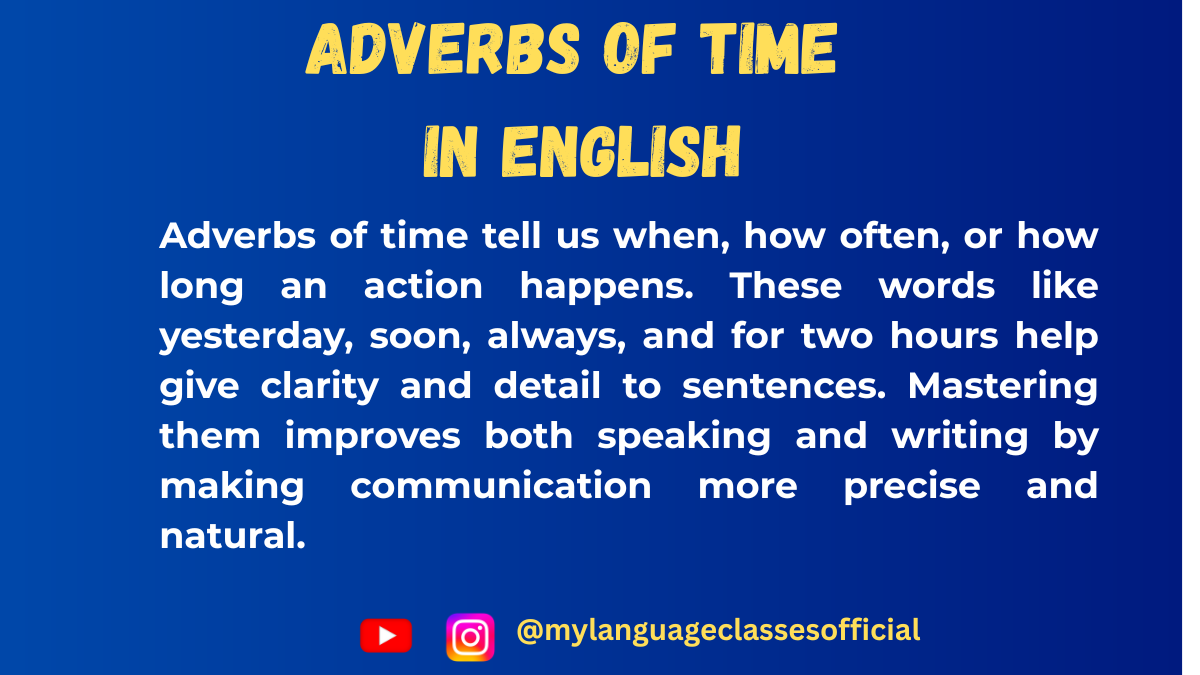
Adverbs of Time in English Grammar
Adverbs of time are an essential part of English grammar, as they help describe when an action takes place. They provide clarity to sentences by indicating past, present, or future time and are commonly used in both spoken and written English.
Understanding adverbs of time is crucial for effective communication, as they allow speakers and writers to express when an event happens, how often it occurs, and for how long. Without these adverbs, sentences can lack important time-related details, leading to confusion.
In this blog post, we will explore common adverbs of time, their grammar rules, different usage scenarios, and example sentences. Additionally, we will provide a practice exercise to help reinforce your understanding of this topic. By the end of this guide, you will have a strong grasp of how to use adverbs of time correctly and naturally in your conversations and writing.
Common Expressions Using Adverbs of Time
Adverbs of time often appear in common everyday expressions that we use in conversations. These expressions help clarify when events occurred, are occurring, or will occur. Below is a list of common expressions and phrases that include adverbs of time:
- At the moment – Refers to the present time.
Example: “I’m busy at the moment.” - In a while – Refers to a short period of time in the future.
Example: “I’ll be there in a while.” - At once – Refers to doing something immediately.
Example: “Please respond at once.” - Every day – Refers to daily frequency.
Example: “I go to the gym every day.” - Right now – Refers to the immediate present.
Example: “I need your help right now.” - Later on – Refers to a time after the present.
Example: “We will discuss this later on.” - Soon after – Refers to something happening shortly after.
Example: “The meeting ended, and soon after, I left.” - At times – Indicates occasional occurrence.
Example: “At times, I feel overwhelmed with work.” - In the past – Refers to a time that has already passed.
Example: “I lived in Canada in the past.” - Once in a while – Indicates infrequent occurrence.
Example: “I treat myself to chocolate once in a while.”
Grammar Rules for Using Adverbs of Time
Adverbs of time have specific grammatical rules that govern their use. Understanding these rules will ensure that you use these adverbs correctly in your sentences.
General Structure
- Position in the Sentence: Adverbs of time generally appear at the end of the sentence, but they can also appear at the beginning or in the middle depending on the emphasis and context.
- Example (end): “She called yesterday.”
- Example (beginning): “Yesterday, she called.”
- Example (middle): “She always calls at night.”
- Use of Articles: Adverbs of time do not require articles, as they modify the verb and indicate the time of the action.
- Plural and Gender: Adverbs of time do not change based on number or gender. They are invariant.
- Types of Adverbs of Time:
- Definite: Refers to specific times (e.g., “now,” “today,” “yesterday”).
- Indefinite: Refers to general time periods (e.g., “soon,” “later,” “soon after”).
Common Adverbs of Time and Example Sentences
Here’s a list of common adverbs of time along with example sentences:
- Now: “She is working now.”
- Soon: “We will leave soon.”
- Yesterday: “I visited the museum yesterday.”
- Today: “The weather is perfect today.”
- Later: “I will call you later.”
- Before: “She had left before I arrived.”
- Afterwards: “We went for coffee afterwards.”
- Always: “I always drink coffee in the morning.”
- Never: “I never go to bed late.”
- Often: “She often goes for a walk in the evening.”
- Frequently: “He frequently travels for work.”
- Seldom: “I seldom watch TV.”
When to Use Adverbs of Time
Adverbs of time are used in various situations to give more information about the time frame of an action. Below are the key situations where adverbs of time are used, along with examples:
1. Present Time
Adverbs of time are commonly used to talk about actions happening now or regularly.
- Example: “She always drinks tea in the morning.”
- Usage: In habitual actions or routines.
2. Past Time
Adverbs of time indicate that an action occurred at a specific time in the past.
- Example: “I visited Paris last summer.”
- Usage: To describe something that happened in the past.
3. Future Time
Adverbs of time are used to express when something will happen in the future.
- Example: “We will meet tomorrow.”
- Usage: To indicate future actions or events.
4. To Indicate Frequency
Adverbs like always, never, and often describe how frequently something happens.
- Example: “I always go for a jog in the evening.”
5. To Specify Duration
Adverbs like for and since specify the length of time for which something happens.
- Example: “She has been waiting since 10 AM.”
6. To Indicate Immediacy
Adverbs like now, immediately, and right away indicate that an action is taking place at this moment or will take place immediately.
- Example: “I need to leave right now.”
Things to Keep in Mind
When using adverbs of time, there are a few things to consider to ensure you don’t make mistakes. Here are some tips and tricky points:
- Placement of Adverbs:
- While adverbs of time usually go at the end of a sentence, they can also go at the beginning for emphasis.
- Incorrect: “She will never forget this.”
- Correct: “She will never forget this.”
- Use of Tenses:
- Pay attention to the tense when using adverbs of time. For example, use yesterday with past tense, and soon with future tense.
- Avoid Overuse:
- Don’t overuse adverbs of time like always, never, and often. Using them too much can make your sentences sound repetitive.
Example Table
Here are some example sentences that demonstrate the use of adverbs of time in different contexts:
Adverb of Time Sentence Now She is eating now. Later I will visit you later. Yesterday He arrived yesterday. Tomorrow We are leaving tomorrow. Soon She will call soon. Never I never go to bed late. Always I always wake up early. Afterward We went to the park afterward. Before He left before I arrived. Sometimes I sometimes skip breakfast. Seldom She seldom eats junk food. Occasionally We meet occasionally. Frequently He travels frequently for work. In the past I lived in London in the past. Once in a while I go to the movies once in a while.
More Example Sentences
- She went for a walk right now.
- I see him frequently at the library.
- Every day, I learn something new.
- We will start the meeting in a few minutes.
- I met her once in Paris.
- I plan to finish my work soon.
- He called me yesterday.
- I will tell you everything later.
- I’m visiting my parents this weekend.
- She always helps me with my homework.
Exercise
Fill in the blanks with the appropriate adverb of time:
- I am going to the gym _______.
- She leaves work _______.
- We will have dinner _______.
- He arrived _______.
- I will call you _______.
- She comes to the office _______.
- The concert will start _______.
- I have not seen him _______.
- They will arrive _______.
- I see my friends _______.
Answers:
- I am going to the gym every day.
- She leaves work early.
- We will have dinner soon.
- He arrived yesterday.
- I will call you later.
- She comes to the office every morning.
- The concert will start in an hour.
- I have not seen him for a long time.
- They will arrive tomorrow.
- I see my friends occasionally.
Conclusion
Mastering adverbs of time is essential for clear and effective communication in English. With the knowledge of how to use these adverbs, when to use them, and the rules governing their usage, you will improve your speaking and writing skills. Be mindful of placement, tense, and the frequency of adverbs to avoid errors. Keep practicing, and soon you will use adverbs of time like a pro!
👉 Visit our blog: mylanguageclassesblog.wordpress.com
👉 Follow on Instagram for daily tips
👉 Subscribe on YouTube for fun grammar videos.Let’s grow your English fluency together—one word at a time!
- At the moment – Refers to the present time.
-
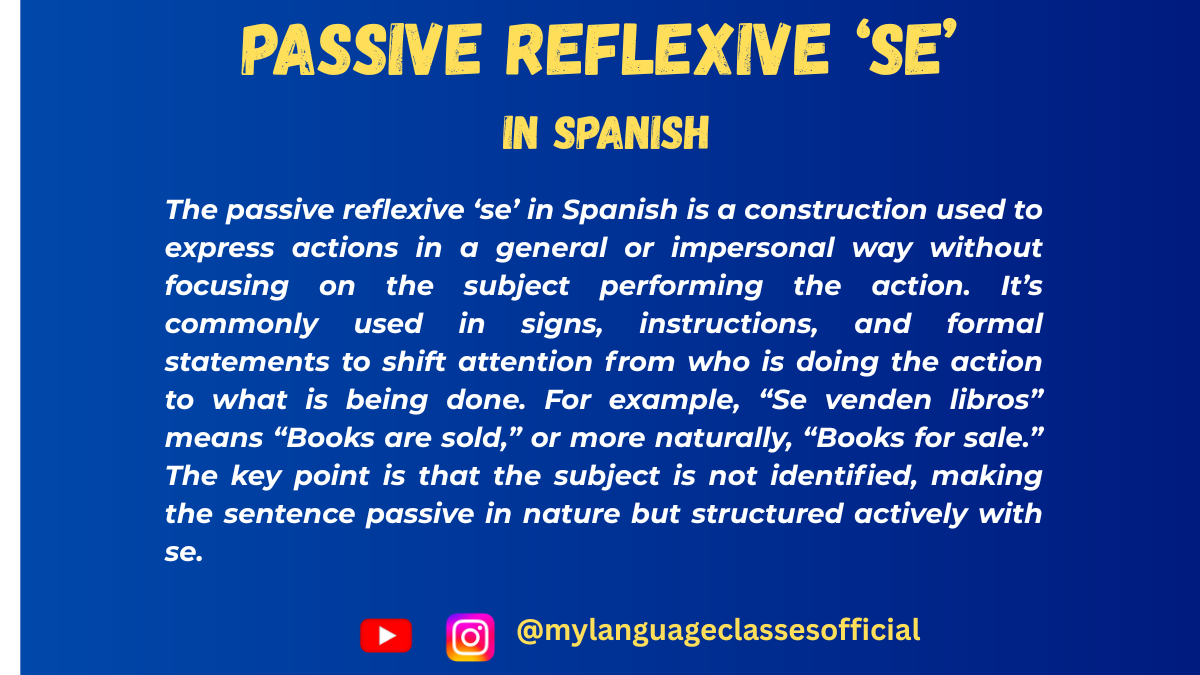
Mastering the Passive Reflexive ‘Se’ in Spanish
The passive reflexive ‘se’ is one of the most versatile and commonly used constructions in the Spanish language. It allows speakers to express actions in a way that emphasizes the action itself rather than who is performing it. This structure is particularly useful when the subject is unknown, irrelevant, or generalized. For example, instead of saying “Someone sells fruits here,” you can say “Se venden frutas aquí,” which translates to “Fruits are sold here.”
Understanding the passive reflexive ‘se’ is essential for achieving fluency in Spanish, as it appears frequently in both spoken and written language.
In this blog post, we’ll explore its usage, conjugation, common expressions, and everything you need to know to master this grammatical structure.
Common Expressions Using Passive Reflexive
The passive reflexive ‘se’ is used in many everyday expressions. Here’s a list of common ones:
- Se habla español – Spanish is spoken.
- Se venden casas – Houses are sold.
- Se necesita ayuda – Help is needed.
- Se prohíbe fumar – Smoking is prohibited.
- Se permite estacionar – Parking is allowed.
- Se dice que… – It is said that…
- Se recomienda reservar – It is recommended to book.
- Se ofrecen clases – Classes are offered.
- Se busca empleado – Employee wanted.
- Se alquila apartamento – Apartment for rent.
These expressions are widely used in signs, advertisements, and general conversation.
Things to Keep in Mind
When using the passive reflexive ‘se,’ there are a few key points to remember:
- Articles and Agreement: The verb must agree in number (singular or plural) with the subject. For example:
- Se vende la casa (The house is sold) – Singular.
- Se venden las casas (The houses are sold) – Plural.
- Gender Agreement: While the verb doesn’t change for gender, the noun or adjective accompanying it does. For example:
- Se venden camisas rojas (Red shirts are sold).
- No Specific Subject: The passive reflexive ‘se’ is used when the subject performing the action is either unknown or unimportant.
- Avoiding Redundancy: Unlike English, Spanish often omits the subject entirely when using the passive reflexive. For example, instead of saying “Se venden las manzanas por alguien” (Apples are sold by someone), simply say “Se venden las manzanas.”
When to Use the Passive Reflexive ‘Se’
The passive reflexive ‘se’ is used in the following situations:
- General Statements: When making broad or general statements.
- Se come bien en México (People eat well in Mexico).
- Impersonal Actions: When the subject is unknown or irrelevant.
- Se construyó este edificio en 1990 (This building was built in 1990).
- Instructions or Warnings: In signs, manuals, or public notices.
- Se prohíbe el paso (No entry allowed).
- Advertising or Offers: To promote products or services.
- Se venden coches usados (Used cars for sale).
Conjugation of Regular Verbs in Passive Reflexive
The passive reflexive ‘se’ is formed by combining the pronoun ‘se’ with the third-person singular or plural form of the verb, depending on the subject. Here’s how it works for regular verbs:
1. -AR Verbs
- Hablar (to speak): Se habla / Se hablan
- Se habla español aquí (Spanish is spoken here).
- Se hablan muchos idiomas (Many languages are spoken).
2. -ER Verbs
- Vender (to sell): Se vende / Se venden
- Se vende la casa (The house is sold).
- Se venden libros (Books are sold).
3. -IR Verbs
- Abrir (to open): Se abre / Se abren
- Se abre la tienda a las 9 (The store opens at 9).
- Se abren las ventanas (The windows are opened).
Irregular Verbs and Their Conjugation
Some irregular verbs also follow the passive reflexive structure. Here are a few examples:
- Hacer (to do/make): Se hace / Se hacen
- Se hace el trabajo (The work is done).
- Se hacen pasteles (Cakes are made).
- Decir (to say): Se dice / Se dicen
- Se dice que es verdad (It is said to be true).
- Se dicen muchas cosas (Many things are said).
- Poner (to put): Se pone / Se ponen
- Se pone la mesa (The table is set).
- Se ponen los libros aquí (The books are put here).
10 Regular Verbs in Passive Reflexive Form
Verb Example Sentence 1 Example Sentence 2 Hablar Se habla español aquí. (Spanish is spoken here.) Se hablan muchos idiomas. (Many languages are spoken.) Vender Se vende la casa. (The house is sold.) Se venden coches usados. (Used cars are sold.) Abrir Se abre la puerta. (The door is opened.) Se abren las ventanas. (The windows are opened.) Comer Se come bien en este restaurante. (People eat well at this restaurant.) Se comen las manzanas. (The apples are eaten.) Escribir Se escribe una carta. (A letter is written.) Se escriben libros interesantes. (Interesting books are written.) Leer Se lee el periódico. (The newspaper is read.) Se leen muchos libros. (Many books are read.) Cerrar Se cierra la tienda. (The store is closed.) Se cierran las ventanas. (The windows are closed.) Comprar Se compra pan fresco. (Fresh bread is bought.) Se compran regalos. (Gifts are bought.) Limpiar Se limpia la casa. (The house is cleaned.) Se limpian los platos. (The dishes are cleaned.) Usar Se usa el teléfono. (The phone is used.) Se usan computadoras. (Computers are used.)
More Example Sentences
- Se venden flores en el mercado. (Flowers are sold at the market.)
- Se necesita paciencia. (Patience is needed.)
- Se construyen casas nuevas. (New houses are built.)
- Se habla mucho de política. (Politics is talked about a lot.)
- Se permite nadar aquí. (Swimming is allowed here.)
- Se ofrecen descuentos. (Discounts are offered.)
- Se busca un perro perdido. (A lost dog is being searched for.)
- Se alquilan bicicletas. (Bicycles are rented.)
- Se recomienda llegar temprano. (It is recommended to arrive early.)
- Se dice que va a llover. (It is said that it will rain.)
Fill in the Blanks
- Se _______ (vender) frutas en el mercado.
- Se _______ (necesitar) más tiempo.
- Se _______ (hablar) español en Argentina.
- Se _______ (permitir) estacionar aquí.
- Se _______ (construir) un nuevo edificio.
- Se _______ (ofrecer) clases de yoga.
- Se _______ (buscar) un gato perdido.
- Se _______ (alquilar) coches baratos.
- Se _______ (recomendar) leer este libro.
- Se _______ (decir) que es verdad.
Answers:
- venden
- necesita
- habla
- permite
- construye
- ofrecen
- busca
- alquilan
- recomienda
- dice
Conclusion
The passive reflexive ‘se’ is a powerful and versatile tool in Spanish that allows you to express actions in a clear and concise manner. By mastering its usage, conjugation, and common expressions, you’ll be able to communicate more effectively and naturally in Spanish. Whether you’re reading signs, giving instructions, or making general statements, the passive reflexive ‘se’ will undoubtedly enhance your language skills.
Practice regularly, pay attention to agreement rules, and soon you’ll find yourself using this construction with confidence.
¡Buena suerte! (Good luck!)
If you enjoyed this lesson, be sure to check out more posts like this on my blog at My Language Classes. Don’t forget to subscribe my YouTube channel and follow me on Instagram for the latest language learning tips and lessons. Leave a comment below to share your thoughts, or ask any questions you have about nouns.
Happy learning! 😊
- 100 Spanish Example Sentences
- 100 Spanish Fill-in-the-Blanks Exercises
- 100 Spanish Vocabulary Lists
- Spanish – Advanced
- Spanish – Beginner
- Spanish – Intermediate
-
100 Example Sentences of Linking Verbs in English | My Language Classes
Linking Verbs in English
Linking verbs are a crucial part of English grammar, connecting the subject of a sentence to a subject complement that describes or identifies it. While understanding the concept of linking verbs is important, seeing them in action through examples can make their usage even clearer.
In this blog post, we’ve compiled 100 example sentences of linking verbs to help you grasp how they work in real-life contexts. Whether you’re a student, teacher, or language enthusiast, these sentences will serve as a valuable resource for learning and teaching.
Let’s dive into the examples!
100 Example Sentences of Linking Verbs
- She is a doctor.
- The cake smells delicious.
- He seems tired after work.
- The flowers look beautiful.
- I am a teacher.
- The soup tastes salty.
- They are my best friends.
- The weather feels cold today.
- The movie was boring.
- She became a lawyer last year.
- The children appear excited.
- The room remains quiet.
- The sky looks cloudy.
- He seems happy with the results.
- The music sounds relaxing.
- The dog is playful.
- The book was interesting.
- She feels nervous about the exam.
- The coffee tastes bitter.
- The house looks old.
- They were late to the party.
- The cake appears burnt.
- The teacher is kind.
- The soup smells amazing.
- He became a father last month.
- The flowers smell sweet.
- The idea sounds great.
- The fabric feels soft.
- The problem remains unsolved.
- The children stay calm.
- The weather stays warm.
- The cake looks delicious.
- She is a talented singer.
- The movie seems interesting.
- The pizza tastes cheesy.
- The dog seems friendly.
- The house appears empty.
- The sky became dark.
- The water feels cold.
- The story sounds fascinating.
- The room looks messy.
- The cake smells sweet.
- He is a professional athlete.
- The flowers look fresh.
- The soup tastes spicy.
- The music sounds loud.
- The weather feels humid.
- The book remains unfinished.
- The children seem happy.
- The house feels cozy.
- The cake appears perfect.
- The dog became restless.
- The teacher seems strict.
- The flowers smell lovely.
- The movie sounds exciting.
- The soup looks thick.
- The room feels warm.
- The cake tastes heavenly.
- The sky looks clear.
- The children appear curious.
- The weather feels chilly.
- The book sounds interesting.
- The house looks modern.
- The dog seems loyal.
- The teacher remains patient.
- The flowers look vibrant.
- The soup smells savory.
- The music sounds soothing.
- The cake feels soft.
- The sky appears blue.
- The children seem energetic.
- The weather feels pleasant.
- The book looks old.
- The dog appears hungry.
- The teacher sounds knowledgeable.
- The flowers smell fragrant.
- The soup tastes bland.
- The music sounds melodic.
- The cake looks moist.
- The sky feels vast.
- The children remain quiet.
- The weather feels unpredictable.
- The book seems fascinating.
- The dog looks tired.
- The teacher appears approachable.
- The flowers smell fresh.
- The soup tastes rich.
- The music sounds harmonious.
- The cake feels fluffy.
- The sky looks stunning.
- The children seem playful.
- The weather feels refreshing.
- The book remains popular.
- The dog seems protective.
- The teacher looks professional.
- The flowers smell delightful.
- The soup tastes flavorful.
- The music sounds rhythmic.
- The cake looks irresistible.
- The sky feels endless.
Conclusion
Linking verbs are simple yet powerful tools in English grammar, helping to connect subjects with their descriptions or identities. By studying these 100 example sentences, you can see how linking verbs function in various contexts and improve your understanding of their usage. Whether you’re writing, speaking, or teaching, these examples will serve as a handy reference. Keep practicing, and soon, using linking verbs will become second nature to you!
If you found this guide helpful, I’d love to hear from you! Share your thoughts in the comments below or connect with me on social media. For more tips, resources, and inspiration, visit my blog at mylanguageclassesblog.wordpress.com. Follow on Instagram and subscribe on YouTube

